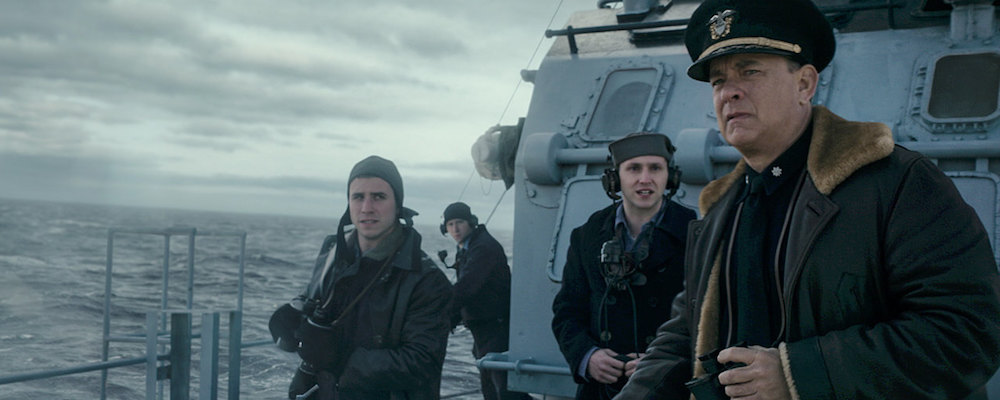Tom Hanks Wages Battle at Sea in World War II Adventure ‘Greyhound’
Alci Rengifo
“Greyhound” is a film about war at sea, pure and simple. It makes no bones about having an old-fashioned spirit and focusing for an hour and a half mostly on how merchant ships and U-boats squared off during World War II. Releasing exclusively on Apple TV Plus, “Greyhound” stars Tom Hanks in the kind of role John Wayne or Charlton Heston would have played back in the day, standing on deck with rugged gaze. Little is necessarily new here, but it’s efficiently pulled off.
“Greyhound” begins in December 1941 soon after Pearl Harbor and Navy veteran Captain Ernest Krause (Hanks) proposes to his girlfriend Evelyn (Elisabeth Shue) before going off to prepare to jump into the war. Cut to Krause commanding the Greyhound, a destroyer leading three other battleships protecting 37 merchant vessels bringing supplies to the Allies in England. The convoy must cross the North Atlantic which is being patrolled by German U-boats. One of these U-boats, The Grey Wolf, begins to strike just as the Greyhound and its comrades enter the “Black Pit,” a zone where surveillance aircraft are out of range. A very deadly cat and mouse game ensues as Krause, in charge of his first ever crossing, has to outmaneuver the Germans and prevent heavy losses.
There is not much else to “Greyhound” other than its taste for high tension out at sea. Hanks not only stars in the movie, he also wrote it, adapting the screenplay from the 1955 novel “The Good Shepherd” by C.S. Forester. Forester was adept in tales of heroism on ships. His most famous works are the Horatio Hornblower series about the Napoleonic Wars. Hanks himself has been on a World War II kick as a producer since he starred in Steven Spielberg’s “Saving Private Ryan,” helming shows like “Band of Brothers” and “The Pacific.” Director Aaron Schneider also breathes the same patriotic air as seen in his 2003 Oscar-winning short film “Two Soldiers.” They have little interest in exploring any of the deeper elements or even backgrounds of the men on the Greyhound, their goal is to celebrate the heroic, romantic idea of the Allies battling Nazi submarines. The scenes between Krause and Evelyn are incredibly brief, and feel tagged on to give us that expected Greatest Generation love story touch. Every decent World War II leading man has to have a bride waiting back home per Hollywood dictum.
The real movie begins when Krause leads the Greyhound across choppy, restless waters under eternally grey skies. Hanks’s screenplay sounds like he spent every waking moment of its writing memorizing every term, signal and order ever given on a destroyer. In fact his performance consists mostly of issuing commands and sending out communiques. The only time we get a more personal sense of the man is in the opening and closing shots of him praying before going to bed, or when we see the pain in his face at losing a crew member in battle. There’s never a sense of more human flaws, like Gene Hackman in “Crimson Tide.” It’s not that kind of movie. But the ocean sequences are tense and involving enough where we just go along for the ride. Schneider and cinematographer Shelly Johnson capture the cramped feel of the ship, and the familiarity between everyone. Supporting characters like gunnery officer Lopez (Manuel Garcia-Rulfo) and executive officer Charlie Cole (Stephen Graham) are always on edge with little time for expository dialogue, they are simply ready to execute orders. Hanks’s son Chet Hanks brings urgency to Bushnell the sonar operator. The racial segregation of the time is shown via Cleveland (Rob Morgan), the Black messmate who is devoted to Krause’s well-being while acknowledging his lack of privileges in comparison to white crew members. But mostly there are endless, fascinating close ups of charts being pin-pointed and analyzed, sonar signals being deciphered and Morse code messages being flashed from ship to ship.
While the battle scenes are standard material they’re also well-done, with a sense of the vast battle terrain an ocean imposes on the ships. Most of it is CGI, but Schneider never goes for the kind of overkill you find in a movie like last year’s “Midway.” Many of the larger explosions are from a distance, so we can sense Krause’s brutal frustration at seeing his ships being attacked. When a U-boat gets hit by the Allies erupting waves settle into pools of spilled oil. This movie gets so old-fashioned the Germans taunt the Greyhound with radio transmissions cackling, “The Grey Wolf is very hungry! Aooo! Aooo!”
Inevitably there is a heroic ending and the end credits give us all the facts and figures of the Battle of the Atlantic, which is not necessarily a bad thing. Every year we get one or two servings of Hollywood’s eternal love for the World War II generation, who fought such a titanic struggle that they’re still churning out decent popcorn material.
“Greyhound” premieres July 10 on Apple TV+.

